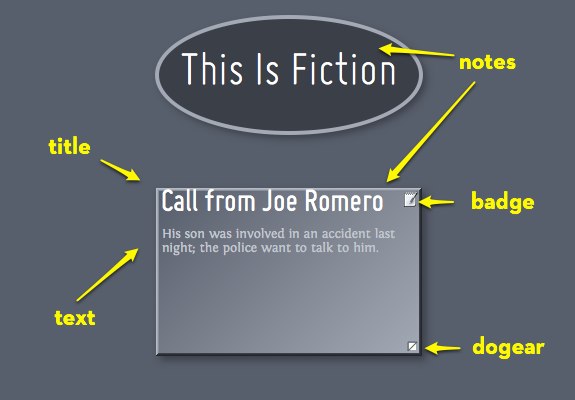Episode 0
The Pitch Meeting
What Happened
We were sitting around the conference table at Eastgate, discussing what people most want to know about Tinderbox.
“How about maps? They’re distinctive. They’re a very important part of Tinderbox. Lately, we’ve been talking a lot about agents and actions and connecting Tinderbox to other programs and to Web services. Let’s give beginners a hand.”
“It’s not just beginners, either. Complex maps raise really challenging questions. And, unlike lots of brainstorming tools, Tinderbox can make maps that are really large and have real representational complexity – maps that raise interesting questions.”
“But what sort of a map should we explore?”
“A legal case! There’s a lot of interest in Tinderbox and the law now, from legislative review to law office management and on to training judges."
"Won’t we get sued?”
“No — it’s a fictitious law case. Any resemblance to any actual places, events, or persons living or dead is entirely coincidental. Keep that in mind!”
"What about education? Management? Research? Policy making?"
"All of them are important. But lots of the same techniques and concepts they use will apply to our legal case, too."
Previously in The Romero File

How We Map It
Tinderbox maps are intended to represent complex information, especially volatile information that you do not understand completely. Maps aren’t simply pretty pictures to impress managers; maps are intended to help you capture information and to understand its structure.
Most importantly, Tinderbox maps can be large and complex; they aren't limited to a handful of jottings. In each episode, we’re going to look at a small corner of a very large map.
Let’s review the basics. A Tinderbox map shows the notes inside a Tinderbox container. Maps also show containers, agents, and adornments — we’ll talk about them soon. Notes are usually rectangular, but they can also have other shapes.
In the map, notes always show their title. Typically, this is the note’s name, though we sometimes arrange for notes to display additional information, too. Notes can also have longer text; if a note has some text, a “dogear” appears in its lower right-hand corner.
A note might also have a badge, which appears in the upper right-hand corner. Badges can help distinguish different kinds of notes, or can draw attention to urgent or exceptional notes.
Every note has a long list of attributes that describe the note. Some attributes are built-in, such as the note’s Shape, Color, Height, and Width. You can define your own attributes, too.
R&D
Though every episode of this series involves techniques you’ll find valuable for the sort of problems that crop up in everybody’s everyday work, many also touch upon subjects of great interest to research in computer science, hypertext research, knowledge representation, programming, and design.
At the end of each episode, I’ll include pointers to interesting research and to open research questions. These notes are meant chiefly for my colleagues, and I’m looking forward to suggestions, observations, and corrections. But computer science is a young field and hypertext is even younger; many important research problems lie close to the surface and don’t require years of study and preparation before new work can be undertaken.

The first and most important lesson in note taking: write it down.
Photo: Natalie Tuke, Brooks Institute.

